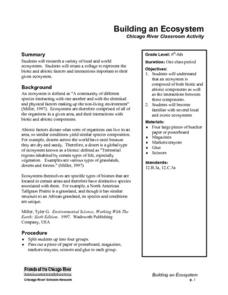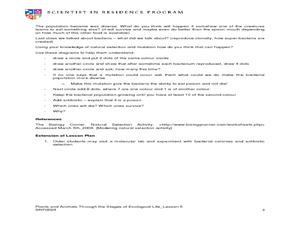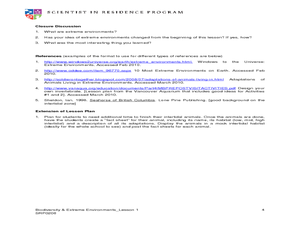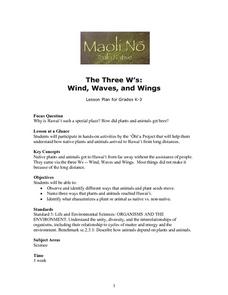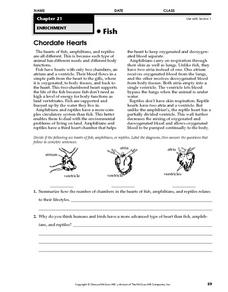Curated OER
Wanted: Invasive Species
Students create a WANTED poster about an invasive species to an ecosystem. In this invasive species lesson plan, students watch a video and research an invasive species and create the WANTED poster about it.
Curated OER
How Do You Know A Panther Was Here?
Students research the signs that panthers leave. In this panther track lesson, students conduct Internet research into the signs that panthers leave such as tracks, scat, scrapes, and scratches. They make a three-dimensional poster using...
Curated OER
What Makes a Cat a Cat?
Young scholars investigate the lives of pets by videotaping them. In this animal life activity, students videotape a cat and other pets using school cameras in a computer lab. Young scholars review the footage from the cat...
Curated OER
Habitat Art: Florida Panthers
Students discover the lifestyles of a Florida Panther by investigating its habitat. For this wild animal lesson, students utilize the Internet to research the habits of a Panther and what their habitat is. Students create an...
Curated OER
Panther Exam: Writing a Play
Students demonstrate their knowledge of panthers by writing a play on the subject. In this animal life lesson, students view a slide-show on school computers of a veterinary exam of a panther. Students utilize this...
Curated OER
Building an Ecosystem
Students research a variety of local and world ecosystems. Students will create a collage to represent the biotic and abiotic factors and interactions important to their given ecosystem.Students will understand that an ecosystem is...
Curated OER
Energy Activities
Students conduct a variety of experiments related to solar energy, heating, cooling, gravity, physical insulation and wind. They consider how the experiments relate to energy and the consumption of energy and then participate in a class...
Curated OER
What's Happening to the Ozone?
Students identify causes of ozone depletion, generalize how that information affects everyday life, and discuss ways individuals can help slow down depletion of ozone.
Curated OER
Water Ways Lesson Plan #1: Who Catches Your Fish?
Students explore the types of fish caught in the Mid-Atlantic region. In this fishing lesson plan, students learn about fishing methods and meet fishermen that catch the fish. Using the water ways website, students research types of...
Curated OER
Habitat Choice in Woodbugs
Students investigate woodbugs. In this scientific investigation lesson, students explore the steps scientists take when conducting an investigation using live specimens. Students explore habitat preferences for woodbugs in various...
Consumers Energy
The Cost of Electricity
How much is your toaster costing you every day? Young environmentalists calculate the monetary costs of household appliances based on their average consumption of wattage.
Orange County Water Atlas
Location, Location, Location…
Young geographers discover not only how to read and recognize coordinates on a map, but also gain a deeper understanding of latitude and longitude and how climate changes can vary significantly across latitudes.
Curated OER
Tread Lightly: Where We Stand
Learners explore the concept of ecological footprints. In this environmental stewardship lesson, students calculate their ecological footprints and consider how to reduce them.
Curated OER
Apply Scientific Inquiry and Scientific Habits of Mind
Students review the components of the scientific inquiry method. In groups, they develop hypothesis on a variety of different topics and design an investigation or experiment to test it. They share their conclusions with the class and...
Curated OER
Making Connections, Linking Population and the Environment
Students find out that all habitats have a carrying capacity. They explore how the world's human population has grown markedly in the 20th century, and that humans impact environmental health. Students investigate that people can and...
Curated OER
Populations- The Survival of the Fittest
Young scholars examine the ways that populations become diverse and how mutation changes the diversity of a population. In this exploratory lesson students study natural selection by completing a lab activity and discussing what...
Curated OER
An Introduction to the Ocean World
Students comprehend how the organisms that exist within the ocean biome, and categorizing each into producer, consumer, or decomposer. They place various human actions under the headings of "hazard" or "help," illustrating how humans can...
Curated OER
Extreme Environments
Students examine extreme environments and the characteristics that make them. In this adaptation instructional activity students see how animals have adapted to these environments.
Curated OER
The Three W's: Wind, Waves, and Wings
Students participate in hands-on acticities to understand how native plants and animals arrived on Hawaii from long distances without the assistance of man. They then identify what characterizes a plant or animal as native vs. non-native.
Curated OER
Chordate Hearts
In this chordate hearts worksheet, students read a passage describing the differences of the hearts of fish, amphibians, and reptiles. After reading, students label diagrams and answer questions.
Curated OER
Genetic Changes
In this genetic change worksheet, students will explore the changes that can occur in DNA including point mutations and chromosomal mutations. This worksheet has 11 multiple choice questions.
Curated OER
Birds
In this birds instructional activity, students review the characteristics of birds including their adaptations for flight. Students review the diversity of bird adaptations. This instructional activity has 4 short answer, 7 true or...
Curated OER
Ecological Impact of Cyanide Heap Leaching
Students explore the environment by researching mining. In this ecological dangers lesson, students define cyanide and discuss why it has potential to be a great threat to our environment during mining expeditions. Students examine many...





